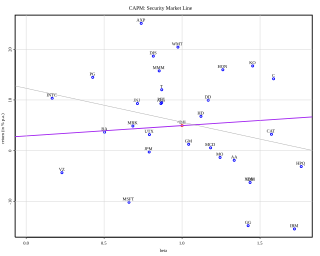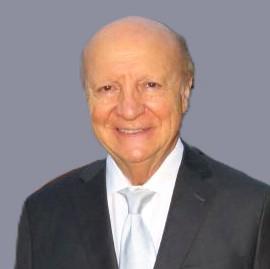
Financial economics is the branch of economics characterized by a "concentration on monetary activities", in which "money of one type or another is likely to appear on both sides of a trade". Its concern is thus the interrelation of financial variables, such as share prices, interest rates and exchange rates, as opposed to those concerning the real economy. It has two main areas of focus: asset pricing and corporate finance; the first being the perspective of providers of capital, i.e. investors, and the second of users of capital. It thus provides the theoretical underpinning for much of finance.

Robert Cox Merton is an American economist, Nobel Memorial Prize in Economic Sciences laureate, and professor at the MIT Sloan School of Management, known for his pioneering contributions to continuous-time finance, especially the first continuous-time option pricing model, the Black–Scholes–Merton model. In 1997 Merton together with Myron Scholes were awarded the Bank of Sweden Prize in Economic Sciences in Memory of Alfred Nobel for the method to determine the value of derivatives.

In finance, the capital asset pricing model (CAPM) is a model used to determine a theoretically appropriate required rate of return of an asset, to make decisions about adding assets to a well-diversified portfolio.
Harry Max Markowitz was an American economist who received the 1989 John von Neumann Theory Prize and the 1990 Nobel Memorial Prize in Economic Sciences.
In finance, arbitrage pricing theory (APT) is a multi-factor model for asset pricing which relates various macro-economic (systematic) risk variables to the pricing of financial assets. Proposed by economist Stephen Ross in 1976, it is widely believed to be an improved alternative to its predecessor, the capital asset pricing model (CAPM). APT is founded upon the law of one price, which suggests that within an equilibrium market, rational investors will implement arbitrage such that the equilibrium price is eventually realised. As such, APT argues that when opportunities for arbitrage are exhausted in a given period, then the expected return of an asset is a linear function of various factors or theoretical market indices, where sensitivities of each factor is represented by a factor-specific beta coefficient or factor loading. Consequently, it provides traders with an indication of ‘true’ asset value and enables exploitation of market discrepancies via arbitrage. The linear factor model structure of the APT is used as the basis for evaluating asset allocation, the performance of managed funds as well as the calculation of cost of capital. Furthermore, the newer APT model is more dynamic being utilised in more theoretical application than the preceding CAPM model. A 1986 article written by Gregory Connor and Robert Korajczyk, utilised the APT framework and applied it to portfolio performance measurement suggesting that the Jensen coefficient is an acceptable measurement of portfolio performance.
The Chartered Financial Analyst (CFA) program is a postgraduate professional certification offered internationally by the US-based CFA Institute to investment and financial professionals. The program teaches a wide range of subjects relating to advanced investment analysis—including business analysis, statistics, probability theory, fixed income, derivatives, economics, financial analysis, corporate finance, alternative investments, portfolio management—and provides a generalist knowledge of other areas of finance.
Financial risk management is the practice of protecting economic value in a firm by managing exposure to financial risk - principally operational risk, credit risk and market risk, with more specific variants as listed aside. As for risk management more generally, financial risk management requires identifying the sources of risk, measuring these, and crafting plans to mitigate them. See Finance § Risk management for an overview.
Chartered Alternative Investment Analyst (CAIA) is a professional designation offered by the CAIA Association to investment professionals who complete a course of study and pass two examinations. The "alternative investments" industry is characterized as dealing with asset classes and investments other than standard equity or fixed income products. Alternative investments can include hedge funds, private equity, real assets, commodities, and structured products.
Financial risk is any of various types of risk associated with financing, including financial transactions that include company loans in risk of default. Often it is understood to include only downside risk, meaning the potential for financial loss and uncertainty about its extent.
Sanford "Sandy" Jay Grossman is an American economist and hedge fund manager specializing in quantitative finance. Grossman’s research has spanned the analysis of information in securities markets, corporate structure, property rights, and optimal dynamic risk management. He has published widely in leading economic and business journals, including American Economic Review, Journal of Econometrics, Econometrica, and Journal of Finance. His research in macroeconomics, finance, and risk management has earned numerous awards. Grossman is currently Chairman and CEO of QFS Asset Management, an affiliate of which he founded in 1988. QFS Asset Management shut down its sole remaining hedge fund in January 2014.
Frank J. Fabozzi is an American economist, educator, writer, and investor, currently Professor of Practice at The Johns Hopkins University Carey Business School and a Member of Edhec Risk Institute. He was previously a Professor of Finance at EDHEC Business School, Professor in the Practice of Finance and Becton Fellow in the Yale School of Management, and a visiting professor of Finance at the Sloan School of Management at the Massachusetts Institute of Technology. He has authored and edited many books, three of which were coauthored with Nobel laureates, Franco Modigliani and Harry Markowitz. He has been the editor of the Journal of Portfolio Management since 1986 and is on the board of directors of the BlackRock complex of closed-end funds.
Zvi Bodie is an American economist, author and professor. He was the Norman and Adele Barron Professor of Management at Boston University, teaching finance at Questrom for 43 years before retiring in 2015. His textbook, Investments, (with Kane and Marcus) is the market leader and is used in the certification programs of the CFA Institute and the Society of Actuaries. Bodie's work has centered on pension finance and investment strategy. He continues to do consulting work and media interviews.
The following outline is provided as an overview of and topical guide to finance:
A portfolio manager (PM) is a professional responsible for making investment decisions and carrying out investment activities on behalf of vested individuals or institutions. Clients invest their money into the PM's investment policy for future growth, such as a retirement fund, endowment fund, or education fund. PMs work with a team of analysts and researchers and are responsible for establishing an investment strategy, selecting appropriate investments, and allocating each investment properly towards an investment fund or asset management vehicle.
Quantitative analysis is the use of mathematical and statistical methods in finance and investment management. Those working in the field are quantitative analysts (quants). Quants tend to specialize in specific areas which may include derivative structuring or pricing, risk management, investment management and other related finance occupations. The occupation is similar to those in industrial mathematics in other industries. The process usually consists of searching vast databases for patterns, such as correlations among liquid assets or price-movement patterns.
David Arthur Hsieh is a professor of finance at the Duke University Fuqua School of Business. He has done extensive research on hedge funds and alternative beta, which includes dynamics of asset prices and their implications for financial risk management and risk and return in hedge funds and commodity funds.
Söhnke Matthias Bartram is a professor in the Department of Finance at Warwick Business School (WBS). He is also a research fellow in the Financial Economics programme and the International Macroeconomics and Finance programme of the Centre for Economic Policy Research (CEPR), a charter member of Risk Who's Who, and a member of an international think tank for policy advice to the German government. Prior to joining the University of Warwick, he held faculty positions at Lancaster University and Maastricht University and worked for several years in quantitative investment management at State Street Global Advisors as Head of the London Advanced Research Center.
Jeremy James Siegel is an American economist who is the Russell E. Palmer Professor of Finance at the Wharton School of the University of Pennsylvania. He appears regularly on networks including CNN, CNBC and NPR, and writes regular columns for Kiplinger's Personal Finance and Yahoo! Finance. Siegel's paradox is named after him.
David Thesmar is a French economist who works as Franco Modigliani Professor Financial Economics at the MIT Sloan School of Management. His research interests include corporate finance, financial intermediation, entrepreneurship and behavioural economics. In 2007, he was awarded the Prize of the Best Young Economist of France.

Enrique R. Arzac is a financial economist and Professor Emeritus of finance and economics at Columbia University specialized in asset pricing and corporate finance. Previously he was tenured Professor of Finance and Economics and served as the Senior Vice-Dean and Chairman of the Finance Division of the Columbia University Graduate School of Business. Before joining Columbia Arzac taught at the University of Buenos Aires, and was Chief Economist of the Latin American Economic Research Foundation.



